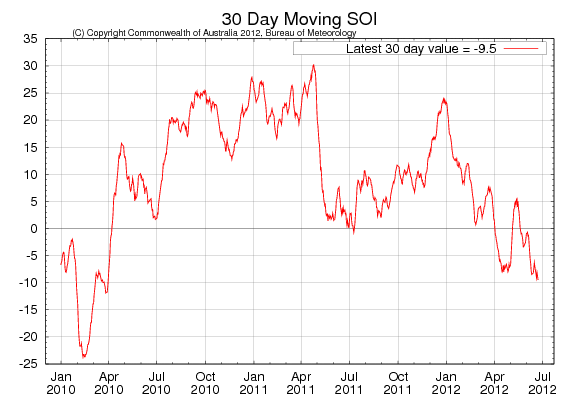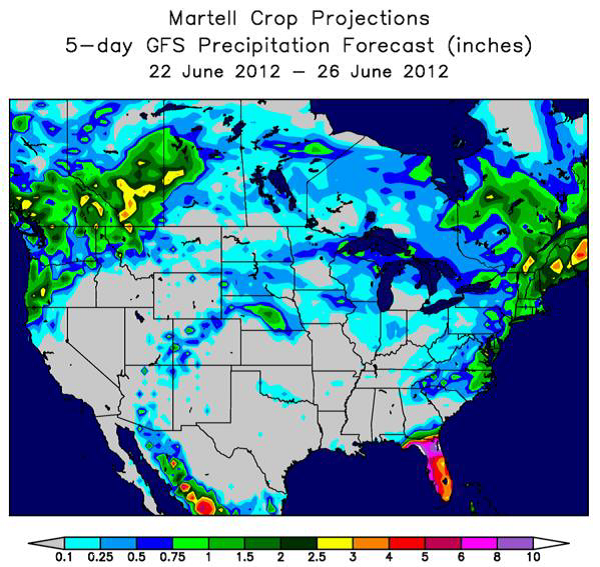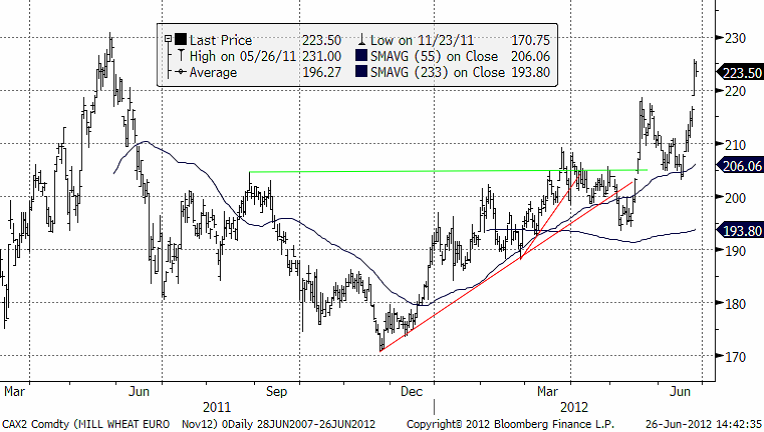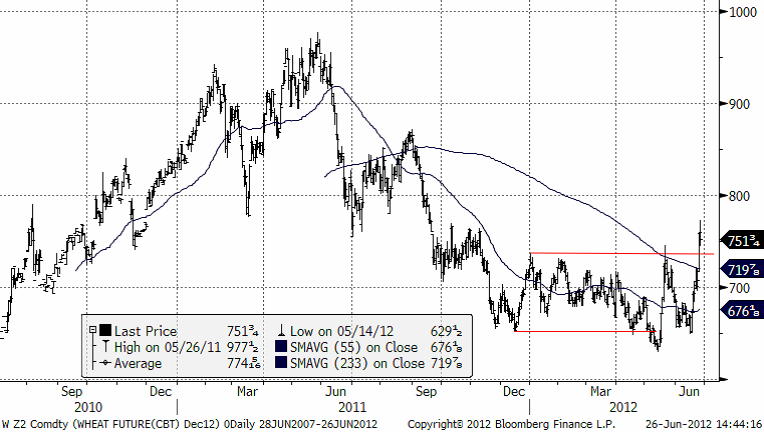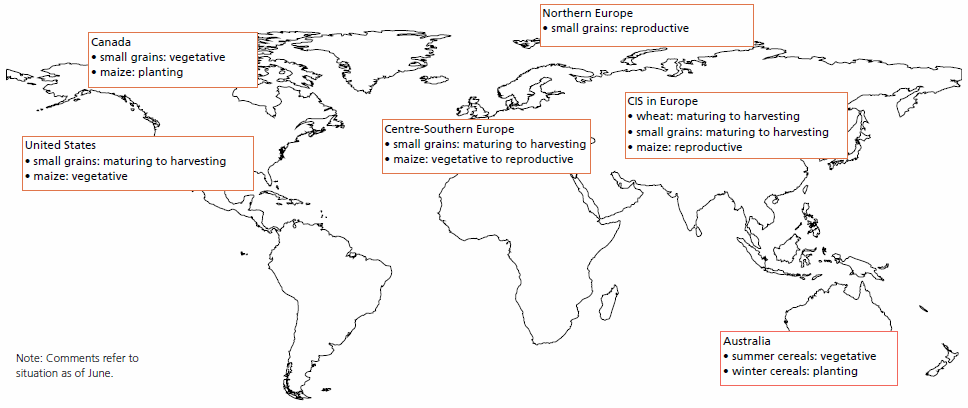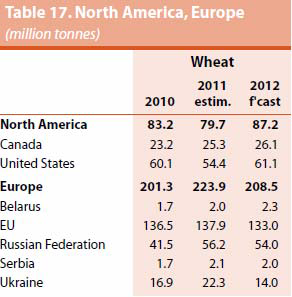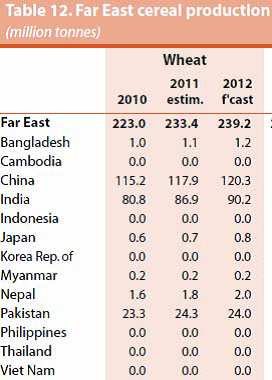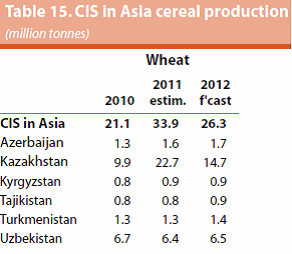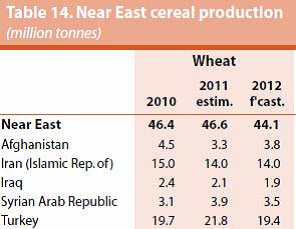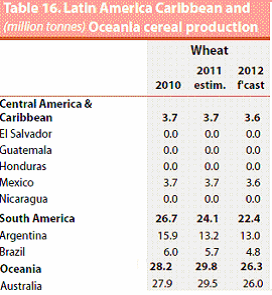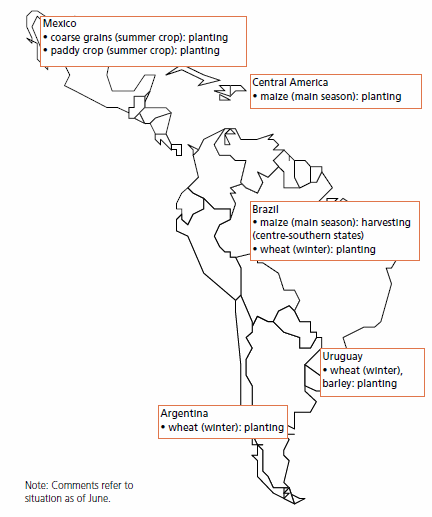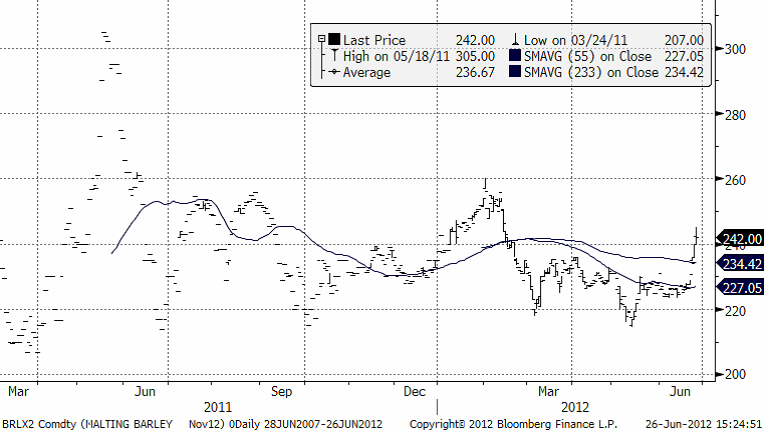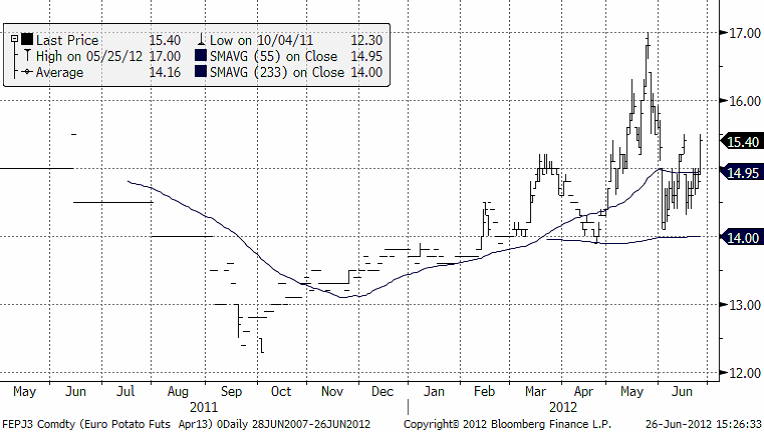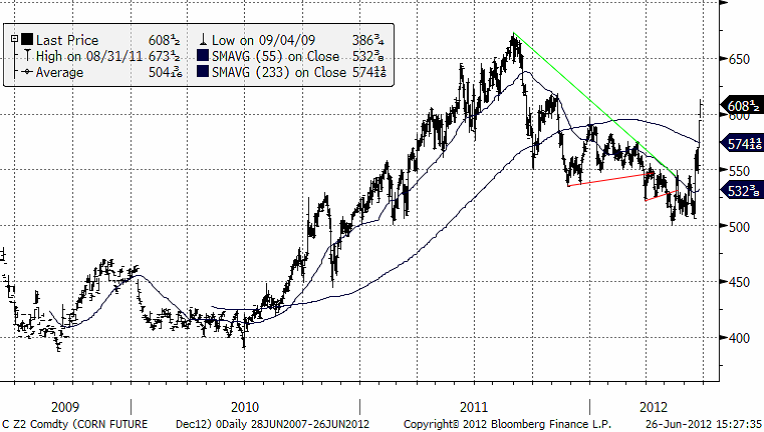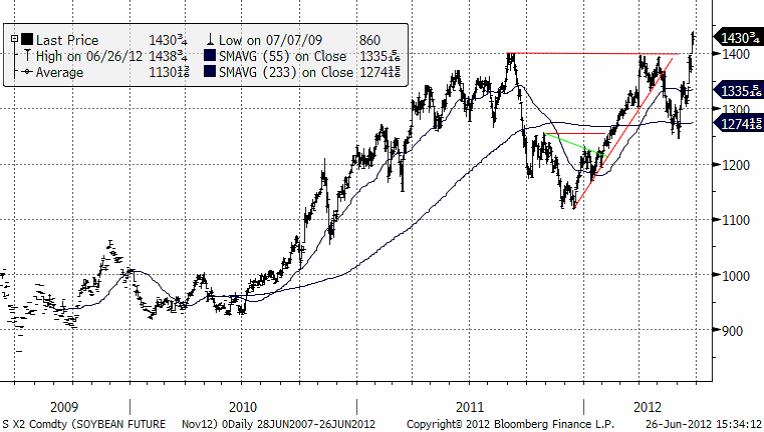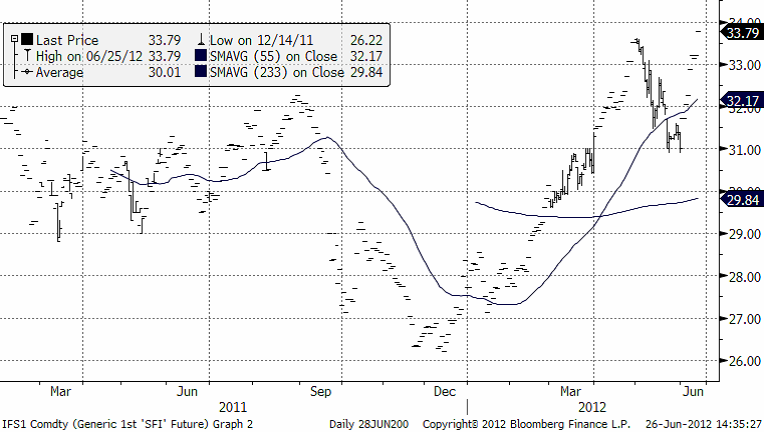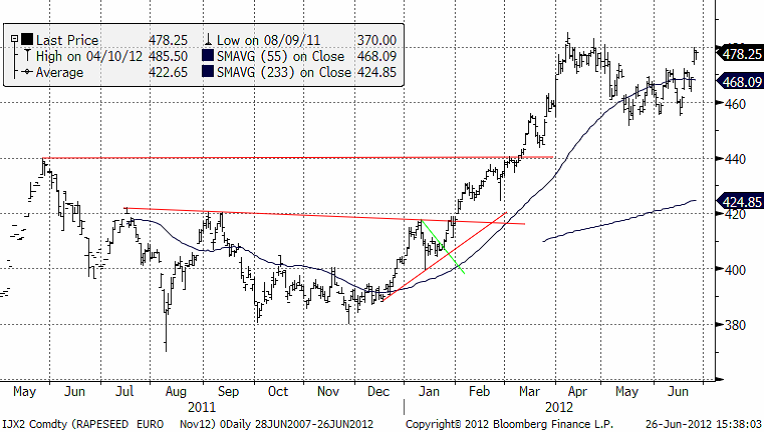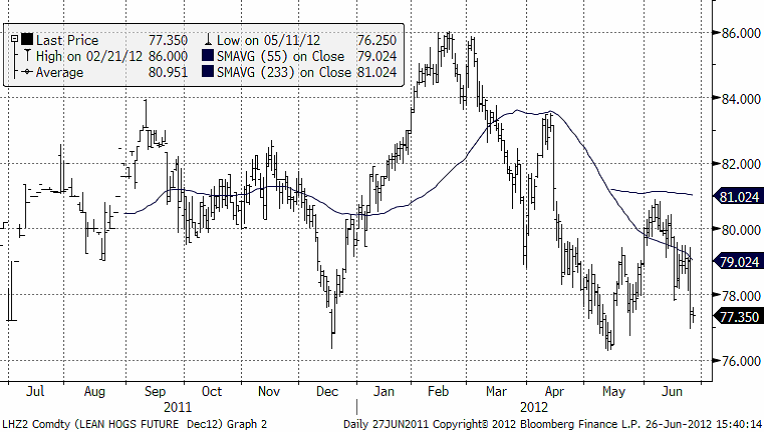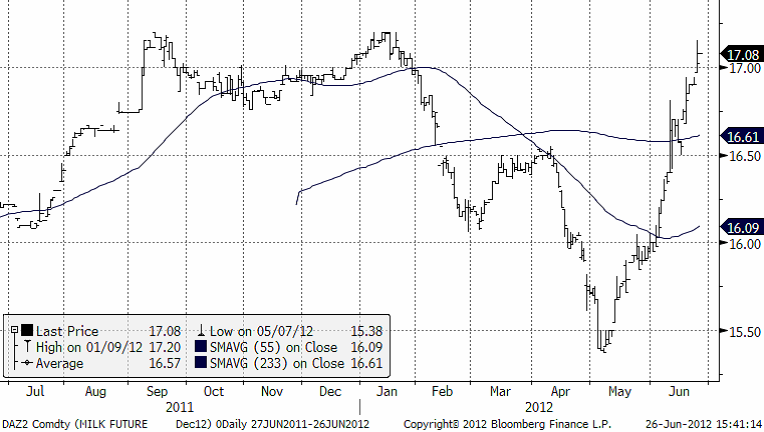Analys
SEB – Jordbruksprodukter, vecka 26 2012
 Inledning
Inledning
Utsikterna för årets skörd har drastiskt försämrats den senaste tiden och därför ändrar vi vår marknadstro till positiv för priserna på en rad grödor. Teknisk analys stödjer detta då vi noterar köpsignaler i flera marknader för grödor som skördas nu under sommaren på norra halvklotet.
Odlingsväder
Southern Oscillation Index, ett mått på intensiteten i graden av La Niña eller El Niño, sjunkit lägre. Aktuell notering är -9.5. Ett värde lägre än -8 innebär El Niño. El Niño är bra för globalt odlingsväder.
Det är däremot torrt i USA och i Ryssland just nu och det är det som påverkar priserna uppåt. Nedan ser vi nederbörden i Nordamerika den senaste veckan. Över stora områden har det inte kommit något regn alls.
Nedan ser vi avvikelsen från normal nederbörd för områden i Europa som är relevanta för höstvete.
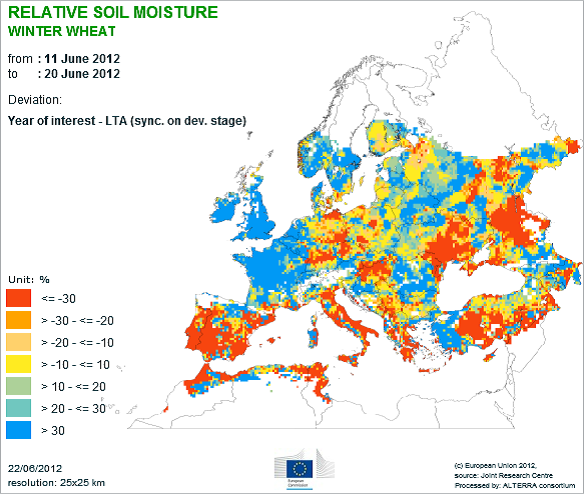 Källa: Martell Crop projections
Källa: Martell Crop projections
Vete
Matifvetet med novemberleverans gjorde ett nytt kliv uppåt från det tekniska stödet på ca 204 – 205 euros nivå. Vid 230 euro, där priset vände ner för ett år sedan, finns ett motstånd.
Nedan ser vi Chicagovetet med leverans i december. Priset har skjutit iväg upp över motståndslinjen och vi har nu en köpsignal. Möjligen kommer en rekyl nedåt och då ska man nog tolka det som ett köptillfälle.
Nedan ser vi hur terminspriserna på Matif och Chicago förändrats den senaste veckan. Det har varit mycket stora förändringar, uppåt. Matif är nu den blå kurvan. Den har gått ännu mer in i backwardation. Chicago är nu den oranga kurvan. Dess contango har minskat och för september 1014 är det till och med lite backwardation. Alla priser är så klart angivna i euro per ton. Vi ser också för övrigt att priserna för leverans i närtid har gått ihop mellan Chicago och Matif.
Som vi skrev om i förra veckans marknadsbrev så uppgår FAO’s senaste prognos för den globala vete produktionen 2012 till 680 mt, vilket är ca 5 mt högre än för en månad sedan, till följd av ökade estimat för Kina och Indien. Den första officiella prognosen i maj för den totala vete produktionen i USA, som baseras på tillståndet för höstvete och estimat för vårgrödorna, pekar på en högre produktion än vad som tidigare har uppskattats. Dessa uppjusteringar uppvägde mer än väl för nedjusteringar i Europa, däribland några EU-länder men i synnerhet för Ryssland.
Kommentarerna i bilden nedan hänvisar till situationen i juni:
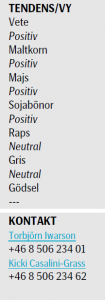 Enligt den nya prognosen, skulle den globala vete produktionen minska med ca 3 procent jämfört med förra året, men fortfarande ligga långt över genomsnittet för de senaste fem åren. Produktionen av vete kvarstår som ett förhållandevis attraktivt alternativ för producenter i världen under 2012, som en följd av höga priser. Ogynnsamma väderförhållanden har dock skadat höstgrödorna i vissa större vete producerande områden och den genomsnittliga avkastningen beräknas bli lägre än förra årets rekord nivåer.
Enligt den nya prognosen, skulle den globala vete produktionen minska med ca 3 procent jämfört med förra året, men fortfarande ligga långt över genomsnittet för de senaste fem åren. Produktionen av vete kvarstår som ett förhållandevis attraktivt alternativ för producenter i världen under 2012, som en följd av höga priser. Ogynnsamma väderförhållanden har dock skadat höstgrödorna i vissa större vete producerande områden och den genomsnittliga avkastningen beräknas bli lägre än förra årets rekord nivåer.
I Nordamerika visar de senaste indikationerna på en stark återhämtning från 2011 och reflekterar ökad sådd och generellt bättre väderförhållanden, som bör leda till högre avkastning, särskilt i de områden som drabbades av torka förra året. I Kanada visar de senaste prognoserna på en ökad produktion genom en ökning av sådd areal under våren i kombination med goda väderförhållanden.
Årets produktion av vete inom EU har äventyrats av en sträng vinter i många delar och prognosen för en genomsnittlig avkastning kan komma att försämras ytterligare om inte tillräckligt med regn kommer snart och lindrar torkan i de centrala EU-länderna, framförallt Ungern och Slovakien. I slutet av maj beräknades EU:s totala vete produktion 2012 att uppgå till 133 mt, en minskning med 3.6 procent jämfört med förra året.
I Ryssland pekar de senaste indikationerna på en 4 procentig minskning av vete produktionen till 54 mt. Mer regn behövs i de södra delarna, i annat fall riskerar avkastningen att sjunka under nuvarande estimerade nivåer.
En kraftig nedgång i produktionen av vete förväntas i Ukraina, framförallt som en följd av ogynnsamma väderförhållanden denna säsong. Genom kraftigt minskad skördad areal och lägre avkastning beräknas produktionen uppgå till 14 mt, vilket är 40 procent lägre än förra årets rekordskörd och långt under genomsnittet för de senaste fem åren.
I Asien är man i slutskedet av 2012 års skörd och de senaste estimaten pekar på en rekordproduktion på 239 mt för Fjärran Östern, en ökning med 2.5 procent från förra årets höga nivåer. Rekordskördar av vete i Kina och Indien återspeglar höga priser för producenterna i kombination med gynnsamma förhållanden och tillräcklig tillförsel av vatten, gödning mm. I den asiatiska delen av OSS så förväntas vete produktionen i Kazakstan att minska kraftigt med ungefär en tredjedel från förra året till 14.7 mt på grund av lägre odlad areal tillsammans med torrt väder och höga temperaturer.
I Mellanöstern, bedöms den sammanlagda veteskörden att uppgå till 44 mt, en minskning med ca 5 procent från förra året. I Nordafrika kvarstår utsikterna som blandade, med sämre prognoser för Marocko där torka har minskat avkastningspotentialen kraftigt, medan det ser bättre ut i Algeriet och Tunisien.
På det södra halvklotet, pågår sådden av höstgrödor i vissa delar av Australien men regn behövs i de nordöstra och östra områdena innan man kan börja. Tidiga indikationer pekar på en minskad vete areal efter förra årets höga nivå, och avkastningen förväntas återgå till genomsnittliga nivåer. I och med det beräknas produktionen preliminärt att sjunka med nästan 12 procent till 26 mt.
I Sydamerika pågår sådden av vete i de flesta länderna och tidiga prognoser pekar på en minskning med 7 procent från förra årets nivå till följd av lägre odlad areal hos de största producenterna, Argentina, Brasilien och Uruguay, där lantbrukare föredrar mer lönsamma grödor.
Strategie Grains, har justerat upp sin prognos för Europas grödor, och höjer sitt estimat för produktionen av vete med 1.5 mt till 124.2 mt som en följd av gynnsamt väder. Revideringen inkluderar högre estimat för Frankrike (+900 000 ton), Tyskland (+500 000 ton), Litauen, (+300 000 ton) och Bulgarien (+300 000 ton), något som uppväger för nedjusteringar i Polen och Rumänien med 300 000 ton för respektive. Beroende på framtida väderförhållanden kan avkastningsprognosen fortfarande öka för länder i de västra och norra delarna av EU, och ytterligare regn kan också generera högra avkastningsprognoser för länder som Tjeckien, Slovakien och Ungern. Prognosen för durumvete höjdes också med 300 000 ton till 7.9 mt, efter rapporter om god kvalitet på i Spanien och södra Italien där skörden har börjat. Export av vete 2012/13 beräknas uppgå till 13.5 mt, en ökning med 2 mt, som en följd av förbättrad produktion samt högre konkurrenskraft gentemot export av amerikanskt vete.
Utsikterna för Rysslands spannmålsskörd justeras ned till följd av ogynnsamma väderförhållanden. Vädret, som fortfarande är varmt och torrt i många regioner, får analysfirman SovEcon att justera ned sin prognos, för andra gången på en månad, från 88.5 mt till 85 mt. Landets produktion av vete justeras ned med 3 mt till 50 mt. Rysslands jordbruksminister justerar också ner sin uppskattning av landets spannmålsproduktion med nästan 10% från 94 mt till 85 mt. Produktionen av vete justeras ned till 46-49 mt, mot tidigare 57 mt och jämfört med USDA’s prognos på 53 mt. Jordbruksministern gjorde ett uttalande häromdagen att det inte finns någon anledning för marknaden att oroa sig för ett ryskt exportstopp. Det är klart han säger det, eftersom det ser ut som det borde komma ett. Efter justeringen av skörden återstår bara 30 mt för inhemsk konsumtion och det brukar alltid konsumeras 38 mt. CNGOIC uppskattar Kinas vete produktion 2012 till 118 mt, en marginell ökning med 0.07% från 2011, men 2.3 mt lägre än deras tidigare prognos från maj och även 2 mt under USDA’s estimat. Produktionen av höstvete beräknas till 111.7 mt mot tidigare 114 mt.
ABARES har justerat ned sin prognos för landets vete produktion 2012/13 med 1.6 mt från tidigare estimat till 24.1 mt, vilket innebär en minskning med 18.3% från förra årets rekordskörd och den lägsta skörden på tre år. Minskningen beror på lägre spannmålspriser som får lantbrukare att avstå från sådd och istället ägna sig åt boskap (får), i kombination med torrt väder under april och maj som försenade sådden.
Den senaste tidens regn har varit gynnsamma men ytterligare nederbörd behövs för att underlätta sådden och grödornas tillväxt för att uppnå genomsnittlig avkastning.
USDA’s estimat från förra tisdagens WASDE-rapport låg kvar på 26 mt för Australien. Arealen för vete har justerats ned med 347 000 hektar till 13.4 miljoner hektar, medan prognosen för landets export av vete har reviderats ned med 500 000 ton till 20.5 mt jämfört med förra årets 22.3 mt.
Buenos Aires Grain Exchange estimerar Argentinas vete areal 2012/13 till 3.8 miljoner hektar, en minskning med 17% från 2011/12, och en fjärdedel av sådden är klar vid det här laget. Argentinas regering har godkänt export av 6 miljoner ton vete under 2012/13. Landet, är världens sjätte största vete exportör och en viktig leverantör till grannlandet Brasilien, men under de senaste åren har lantbrukarna producerat mindre vete som en protest mot regerings export kvotsystem. Det inhemska behovet av vete uppskattas till 6.5 miljoner ton, vilket tyder på att regeringen förväntar sig en skörd på minst 12.5 miljoner ton i år.
USDA sänkte global skörd med 5 mt i junis WASDE och med det väder som varit nu och de rapporter som kommit från olika producentländer, borde julis WASDE innehålla ytterligare en sänkning med 5 mt. Det innebär att skörden ligger 30 mt under förra årets och torkan El Niño, som är positivt för Sydamerika, lär påverka Australien med torka, där det redan är torrt, under hösten.
Maltkorn
Novemberkontraktet på maltkorn har vaknat ur sin slummer och stigit över det prisintervall novemberkontraktet etablerat under våren. Det finns möjligheter för priset att söka sig högre, eventuellt efter en kortare rekyl efter den snabba prisuppgången.
Strategie Grains höjer sin prognos för Europas produktion av korn med 500 000 ton till 53.2 mt, vilket är en ökning med 3% från förra årets 51.6 mt. ABARES justerar ned sitt estimat för Australiens produktion av korn med 1.7 mt från tidigare prognos till 7.3 mt som en följd av lägre förväntad sådd och avkastning.
Potatis
Potatispriset för leverans nästa år, som i slutet av maj var uppe på 17 euro per deciton och sedan såldes ner till 14, tycks vara på väg uppåt igen. Trenden är alltjämt uppåtriktad och vi tror att priset kommer att gå upp.
Majs
Priset på decembermajs bröt den sjunkande trenden, passerade genom 550 cent och stängde ”limit up” ett par dagar i rad. Bakom prisrörelsen ligger den torka och värme som slagit till i USA just när majsen är i pollineringsfas. USDA skar ner crop ratings så att de ligger 10 enheter (good/excellent) under förra årets nivå. Samtidigt har USDA prognosticerat skörden med en avkastning som ligger 19 bushels per acre över förra årets. Nu har USDA väntat sig utgående lager nästa år om 1.88 miljoner bushels, men justerar vi avkastning per acre så att den bättre stämmer med crop ratings hamnar vi på en skörd som är 1.7 miljoner bushels lägre, vilket betyder att det är nära nollan i utgående lager. Vi tar naturligtvis både den ändrade fundamentala situationen och den tekniska styrkan till oss och ändrar vår vy till positiv för priset. På fredag kommer Stocks report från USDA.
Produktionen av majs i Europa beräknas uppgå till 66 mt, upp 400 000 ton sedan förra månaden, och är nästan i linje med förra årets produktion på 66.2 mt enligt Strategie Grains.
Regn under andra hälften av maj har gynnat Brasiliens majsgrödor och 2011/12 års skörd av majs som vintergröda (safrinha) ser mycket bra ut enligt Agroconsult, och beräknas uppgå till 38.8 mt (en ökning med 84% från förra året). Med den siffran beräknas den totala skörden av majs till rekordhöga 73.7 mt , 15 mt mer än det tidigare rekordet som sattes 2007/08 och en bra bit över USDA’s nuvarande prognos på 69 mt.
Buenos Aires Grain Exchange estimerar landets produktion av majs 2012 till 19.3 mt, och 67% procent av skörden är avklarad jämfört med 64.4% för en vecka sedan.
Rosario Grain Exchanges prognos på en produktion om 19 mt är oförändrad från förra månaden.
CNGOIC uppskattar Kinas produktion av majs 2012 till 197.5 mt, oförändrad från tidigare estimat och en uppjustering med 3% från 2011. Prognosen ligger 2.5 mt över USDA’s senaste uppskattning.
Sojabönor
Sojabönorna med novemberleverans bröt oväntat 14 dollar. Det är en stark köpsignal och vi har nu också ett starkt stöd i just 14 dollar.
Buenos Aires Grain Exchange estimerar landets produktion av sojabönor 2011/12 till 39.9 mt, och 96.8% av skörden ör avklarad jämfört med 95% för en vecka sedan.
Rosario Grain Exchange justerar ned sin prognos för Argentinas produktion 2011/12 med 400 000 ton till 40.5 mt. CNGOIC’s senaste prognos för Kinas produktion av sojabönor 2012 är oförändrad och uppgår till 13.0 mt, en minskning med 7.14% från 2011.
ABIOVE uppskattar Brasiliens produktion av sojabönor 2011/12 till 66.2 mt, en ökning från 65.9 mt i april och högre än USDA’s senaste prognos på 65.5 mt. På grund av att den brasilianska valutan, realen, faller, noterar nu det kontantavräknade kontraktet på BM&F i Sao Paulo all-time-high. Nedan ser vi priserna på BM&F angivna i dollar per säck. Pga de höga priserna har bönderna redan säkrat 31% av vinterns kommande skörd. Vanligtvis är det ingen som ens börjat säkra så här års. Liksom med Matif-vetet hösten 2010, där lantbrukarna var snabba med att prissäkra i början på prisuppgången, redan i september, kan det bli brist på osåld vara längre fram på säsongen, som kan få priset att fortsätta stiga.
Raps
Priset på novemberterminen befinner har stigit upp till motståndet på 480 euro per ton. Om 480 euro per ton bryts är det möjligt att vi får se nya kontraktshögsta därefter. Helst skulle vi vilja se att 485.50 bryts som är tidigare kontraktshögsta från den 10 april.
Torka i Australiens östra delar påverkar prognoserna för landet canola produktion, men en ökad canola areal gör att ABARES justerat upp sin prognos för produktionen av canola till 2.94 mt från tidigare 2.93 mt.
AOF (Australian Oilseeds Federation) höjer samtidgt sin prognos för landets canola skörd i år med 231 000 ton till 3.20 mt. Revideringen görs efter en omvärdering av odlingsarealen för canola i New South Wales (NSW), i kombination med att välbehövligt regn i många distrikt har höjt prognosen för areal och avkastning betydligt jämfört med förra månaden.
CNGOIC’s uppskattar Kinas rapsproduktion 2012 till 12.8 mt, ner 4.66% från 2011.
Gris
Decemberkontraktet fortsätter att rekylera nedåt, men ligger nu på låga nivåer, där det bör finnas intresserade köpare.
Mjölk
Mjölkpriset fortsätter sin uppgång från början på maj. Nu ligger priset återigen på toppnivåer. Och gissningsvis finns det en del säljare kvar på den här nivån sedan förra gången priset var uppe här.
[box]SEB Veckobrev Jordbruksprodukter är producerat av SEB Merchant Banking och publiceras i samarbete och med tillstånd på Råvarumarknaden.se[/box]
Disclaimer
The information in this document has been compiled by SEB Merchant Banking, a division within Skandinaviska Enskilda Banken AB (publ) (“SEB”).
Opinions contained in this report represent the bank’s present opinion only and are subject to change without notice. All information contained in this report has been compiled in good faith from sources believed to be reliable. However, no representation or warranty, expressed or implied, is made with respect to the completeness or accuracy of its contents and the information is not to be relied upon as authoritative. Anyone considering taking actions based upon the content of this document is urged to base his or her investment decisions upon such investigations as he or she deems necessary. This document is being provided as information only, and no specific actions are being solicited as a result of it; to the extent permitted by law, no liability whatsoever is accepted for any direct or consequential loss arising from use of this document or its contents.
About SEB
SEB is a public company incorporated in Stockholm, Sweden, with limited liability. It is a participant at major Nordic and other European Regulated Markets and Multilateral Trading Facilities (as well as some non-European equivalent markets) for trading in financial instruments, such as markets operated by NASDAQ OMX, NYSE Euronext, London Stock Exchange, Deutsche Börse, Swiss Exchanges, Turquoise and Chi-X. SEB is authorized and regulated by Finansinspektionen in Sweden; it is authorized and subject to limited regulation by the Financial Services Authority for the conduct of designated investment business in the UK, and is subject to the provisions of relevant regulators in all other jurisdictions where SEB conducts operations. SEB Merchant Banking. All rights reserved.
Analys
Tightening fundamentals – bullish inventories from DOE

The latest weekly report from the US DOE showed a substantial drawdown across key petroleum categories, adding more upside potential to the fundamental picture.

Commercial crude inventories (excl. SPR) fell by 5.8 million barrels, bringing total inventories down to 415.1 million barrels. Now sitting 11% below the five-year seasonal norm and placed in the lowest 2015-2022 range (see picture below).
Product inventories also tightened further last week. Gasoline inventories declined by 2.1 million barrels, with reductions seen in both finished gasoline and blending components. Current gasoline levels are about 3% below the five-year average for this time of year.
Among products, the most notable move came in diesel, where inventories dropped by almost 4.1 million barrels, deepening the deficit to around 20% below seasonal norms – continuing to underscore the persistent supply tightness in diesel markets.
The only area of inventory growth was in propane/propylene, which posted a significant 5.1-million-barrel build and now stands 9% above the five-year average.
Total commercial petroleum inventories (crude plus refined products) declined by 4.2 million barrels on the week, reinforcing the overall tightening of US crude and products.


Analys
Bombs to ”ceasefire” in hours – Brent below $70

A classic case of “buy the rumor, sell the news” played out in oil markets, as Brent crude has dropped sharply – down nearly USD 10 per barrel since yesterday evening – following Iran’s retaliatory strike on a U.S. air base in Qatar. The immediate reaction was: “That was it?” The strike followed a carefully calibrated, non-escalatory playbook, avoiding direct threats to energy infrastructure or disruption of shipping through the Strait of Hormuz – thus calming worst-case fears.

After Monday morning’s sharp spike to USD 81.4 per barrel, triggered by the U.S. bombing of Iranian nuclear facilities, oil prices drifted sideways in anticipation of a potential Iranian response. That response came with advance warning and caused limited physical damage. Early this morning, both the U.S. President and Iranian state media announced a ceasefire, effectively placing a lid on the immediate conflict risk – at least for now.
As a result, Brent crude has now fallen by a total of USD 12 from Monday’s peak, currently trading around USD 69 per barrel.
Looking beyond geopolitics, the market will now shift its focus to the upcoming OPEC+ meeting in early July. Saudi Arabia’s decision to increase output earlier this year – despite falling prices – has drawn renewed attention considering recent developments. Some suggest this was a response to U.S. pressure to offset potential Iranian supply losses.
However, consensus is that the move was driven more by internal OPEC+ dynamics. After years of curbing production to support prices, Riyadh had grown frustrated with quota-busting by several members (notably Kazakhstan). With Saudi Arabia cutting up to 2 million barrels per day – roughly 2% of global supply – returns were diminishing, and the risk of losing market share was rising. The production increase is widely seen as an effort to reassert leadership and restore discipline within the group.
That said, the FT recently stated that, the Saudis remain wary of past missteps. In 2018, Riyadh ramped up output at Trump’s request ahead of Iran sanctions, only to see prices collapse when the U.S. granted broad waivers – triggering oversupply. Officials have reportedly made it clear they don’t intend to repeat that mistake.
The recent visit by President Trump to Saudi Arabia, which included agreements on AI, defense, and nuclear cooperation, suggests a broader strategic alignment. This has fueled speculation about a quiet “pump-for-politics” deal behind recent production moves.
Looking ahead, oil prices have now retraced the entire rally sparked by the June 13 Israel–Iran escalation. This retreat provides more political and policy space for both the U.S. and Saudi Arabia. Specifically, it makes it easier for Riyadh to scale back its three recent production hikes of 411,000 barrels each, potentially returning to more moderate increases of 137,000 barrels for August and September.
In short: with no major loss of Iranian supply to the market, OPEC+ – led by Saudi Arabia – no longer needs to compensate for a disruption that hasn’t materialized, especially not to please the U.S. at the cost of its own market strategy. As the Saudis themselves have signaled, they are unlikely to repeat previous mistakes.
Conclusion: With Brent now in the high USD 60s, buying oil looks fundamentally justified. The geopolitical premium has deflated, but tensions between Israel and Iran remain unresolved – and the risk of missteps and renewed escalation still lingers. In fact, even this morning, reports have emerged of renewed missile fire despite the declared “truce.” The path forward may be calmer – but it is far from stable.
Analys
A muted price reaction. Market looks relaxed, but it is still on edge waiting for what Iran will do

Brent crossed the 80-line this morning but quickly fell back assigning limited probability for Iran choosing to close the Strait of Hormuz. Brent traded in a range of USD 70.56 – 79.04/b last week as the market fluctuated between ”Iran wants a deal” and ”US is about to attack Iran”. At the end of the week though, Donald Trump managed to convince markets (and probably also Iran) that he would make a decision within two weeks. I.e. no imminent attack. Previously when when he has talked about ”making a decision within two weeks” he has often ended up doing nothing in the end. The oil market relaxed as a result and the week ended at USD 77.01/b which is just USD 6/b above the year to date average of USD 71/b.

Brent jumped to USD 81.4/b this morning, the highest since mid-January, but then quickly fell back to a current price of USD 78.2/b which is only up 1.5% versus the close on Friday. As such the market is pricing a fairly low probability that Iran will actually close the Strait of Hormuz. Probably because it will hurt Iranian oil exports as well as the global oil market.
It was however all smoke and mirrors. Deception. The US attacked Iran on Saturday. The attack involved 125 warplanes, submarines and surface warships and 14 bunker buster bombs were dropped on Iranian nuclear sites including Fordow, Natanz and Isfahan. In response the Iranian Parliament voted in support of closing the Strait of Hormuz where some 17 mb of crude and products is transported to the global market every day plus significant volumes of LNG. This is however merely an advise to the Supreme leader Ayatollah Ali Khamenei and the Supreme National Security Council which sits with the final and actual decision.
No supply of oil is lost yet. It is about the risk of Iran closing the Strait of Hormuz or not. So far not a single drop of oil supply has been lost to the global market. The price at the moment is all about the assessed risk of loss of supply. Will Iran choose to choke of the Strait of Hormuz or not? That is the big question. It would be painful for US consumers, for Donald Trump’s voter base, for the global economy but also for Iran and its population which relies on oil exports and income from selling oil out of that Strait as well. As such it is not a no-brainer choice for Iran to close the Strait for oil exports. And looking at the il price this morning it is clear that the oil market doesn’t assign a very high probability of it happening. It is however probably well within the capability of Iran to close the Strait off with rockets, mines, air-drones and possibly sea-drones. Just look at how Ukraine has been able to control and damage the Russian Black Sea fleet.
What to do about the highly enriched uranium which has gone missing? While the US and Israel can celebrate their destruction of Iranian nuclear facilities they are also scratching their heads over what to do with the lost Iranian nuclear material. Iran had 408 kg of highly enriched uranium (IAEA). Almost weapons grade. Enough for some 10 nuclear warheads. It seems to have been transported out of Fordow before the attack this weekend.
The market is still on edge. USD 80-something/b seems sensible while we wait. The oil market reaction to this weekend’s events is very muted so far. The market is still on edge awaiting what Iran will do. Because Iran will do something. But what and when? An oil price of 80-something seems like a sensible level until something do happen.
-

 Nyheter4 veckor sedan
Nyheter4 veckor sedanMahvie Minerals växlar spår – satsar fullt ut på guld
-

 Analys4 veckor sedan
Analys4 veckor sedanA muted price reaction. Market looks relaxed, but it is still on edge waiting for what Iran will do
-

 Nyheter3 veckor sedan
Nyheter3 veckor sedanJonas Lindvall är tillbaka med ett nytt oljebolag, Perthro, som ska börsnoteras
-

 Nyheter3 veckor sedan
Nyheter3 veckor sedanOljan, guldet och marknadens oroande tystnad
-

 Nyheter3 veckor sedan
Nyheter3 veckor sedanDomstolen ger klartecken till Lappland Guldprospektering
-

 Analys3 veckor sedan
Analys3 veckor sedanTightening fundamentals – bullish inventories from DOE
-

 Nyheter2 veckor sedan
Nyheter2 veckor sedanRyska staten siktar på att konfiskera en av landets största guldproducenter
-

 Nyheter2 veckor sedan
Nyheter2 veckor sedanSommarvädret styr elpriset i Sverige


